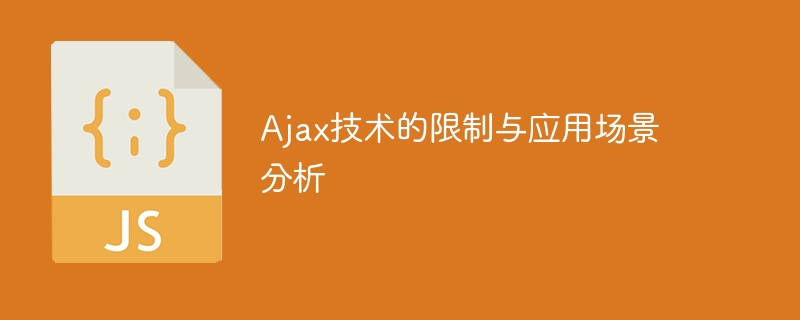

Ajax technology limitations and application scenario analysis
Overview
Ajax (Asynchronous JavaScript and XML) is a technology used to create interactive Web applications. By using JavaScript and the XMLHttpRequest object, Ajax is able to send requests to the server and process them in the background without refreshing the entire page. This makes web applications faster, more efficient, and improves user experience.
However, although Ajax technology has many advantages, there are also some limitations and application scenarios that need to be noted.
1. Restrictions
2. Application scenario analysis
Code example:
var usernameInput = document.getElementById("username");
var feedbackMessage = document.getElementById("feedback");
usernameInput.addEventListener("input", function() {
var username = this.value;
var xhr = new XMLHttpRequest();
xhr.open("POST", "check-username.php", true);
xhr.setRequestHeader("Content-Type", "application/x-www-form-urlencoded");
xhr.onreadystatechange = function() {
if (xhr.readyState === 4 && xhr.status === 200) {
var response = JSON.parse(xhr.responseText);
if(response.exists) {
feedbackMessage.innerHTML = "用户名已存在";
} else {
feedbackMessage.innerHTML = "用户名可用";
}
}
};
xhr.send("username=" + encodeURIComponent(username));
});Code sample:
var contentContainer = document.getElementById("content");
function loadPage(url) {
var xhr = new XMLHttpRequest();
xhr.open("GET", url, true);
xhr.onreadystatechange = function() {
if (xhr.readyState === 4 && xhr.status === 200) {
contentContainer.innerHTML = xhr.responseText;
}
};
xhr.send();
}
// 点击导航链接时动态加载内容
var navLinks = document.getElementsByClassName("nav-link");
for (var i = 0; i < navLinks.length; i++) {
navLinks[i].addEventListener("click", function(event) {
event.preventDefault();
var url = this.href;
loadPage(url);
});
}It should be noted that this way of dynamically loading content needs to consider SEO issues and ensure that a complete URL link is provided to ensure the correctness of search engines index.
Summary
The limitations of Ajax technology mainly involve origin policy, security and SEO issues. Developers should be aware of these restrictions in their applications and take appropriate measures to ensure security and accessibility. At the same time, making full use of Ajax technology in appropriate scenarios can provide a better user experience and make Web applications faster and more efficient.
The above is the detailed content of Analyze the application scope and limitations of Ajax technology. For more information, please follow other related articles on the PHP Chinese website!




